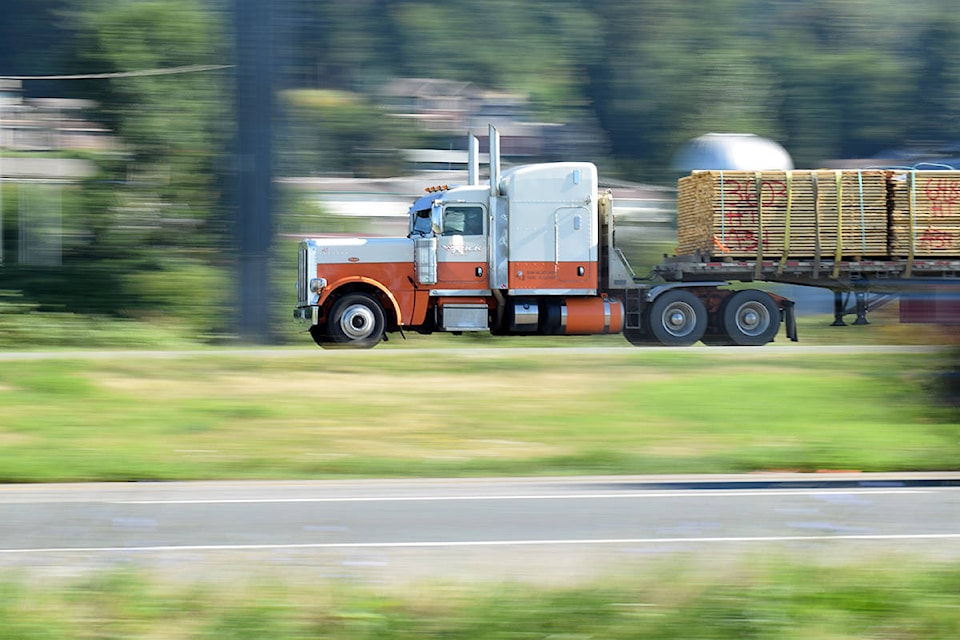Highway 1 between 91ԭ�� and Chilliwack now sees an average of three crashes each day – a rate that has more than doubled in the past two years despite no apparent spike in actual traffic.
In 2017, 1,100 crashes occurred on the highway between 232nd Street and Annis Road in Chilliwack according to the ICBC figures. That’s up from 540 just three years prior. Severe crashes are increasing at the same rate, with the 470 incidents resulting in an injury double the 230 that took place in 2014.
Finding the cause, though, isn’t simple.
The number of vehicles using the highway didn’t actually increase much from 2014 to 2017, according to Ministry of Transportation and Infrastructure numbers. Over those years, as collision rates were dramatically rising, the number of vehicles travelling between Abbotsford and 91ԭ��, increased at a rate of just two per cent each year.
And speeds actually decreased slightly.
One thing that has changed, though, is the amount of truck traffic on Highway 1.
The number of trucks longer than 22.5 metres using the highway has risen by 70 per cent, from a daily average of 1,003 in 2014, to more than 1,700 last year, according to the figures.
“We can’t point a finger at any one thing, it’s a very complex system,” Gord Lovegrove, an associate professor at the University of British Columbia’s school of engineering, said. “But the increase in trucking is also an issue.”
story continues below
That doesn’t necessarily mean the truckers themselves are to blame for the spike in accidents. While BC Trucking Association executive director Dave Earle says truckers have been shown to be the safest drivers on the road, the conduct of other motorists around large vehicles can increase the risk to all drivers.
“As traffic is more and more congested people become more and more likely to switch lanes back and forth looking for the path of least resistance,” he said.
Heavy trucks take much longer to stop, so a driver will leave a larger space in front, Earle said. For other drivers in a hurry, that larger gap becomes a space to use to dart past other cars.
“Drivers generally don’t understand how long it takes a heavy vehicle to come to a stop,” Earle said. “When a passing vehicle dekes into that space, all you can do is hope the truck behind you does not have to stop.”
Earle said there are a number of reasons for the rising number of trucks on Highway 1, including booming development in the Fraser Valley, to a general lack of industrial land in Vancouver that has pushed logistics companies and other haulers further east.
Urbanites might be driving less, he said, “but we still need stuff, we still need food to get to your supermarket.”
And he noted that a survey revealed that BCTA members’ their top wish would be for the provincial government to widen Highway 1 through to Abbotsford.
“We know government is looking at this, but they simply cannot move on this fast enough.”
The need to widen the highway is a frequent refrain from local politicians, including Mayor Henry Braun.
But while the BC Liberals had promised to expand the route through to Abbotsford, the new BC NDP government hasn’t made the same commitment, declaring only that it is studying the issue.
In an emailed response to questions about the issue from The News, a Ministry of Transportation and Infrastructure spokesperson wrote: “In terms of expanding the highway past 216th Street, we are assessing the Highway 1 corridor as a whole through the Fraser Valley to determine the best way to cut down on congestion and increase safety. The ministry considers collision data as well as traffic volumes (historic, current and predicted) when planning transportation improvements.”
Days later, though, the province announced that it will be implementing a variable speed system between Prest Road in Chilliwack and the Sumas River bridge in Abbotsford. The hope is to get drivers to slow down before encountering serious congestion.
Meanwhile, on the widening front, not everyone agrees the highway should be enlarged.
Lovegrove says the province should look at electrifying existing and underused rail corridors, which he said would be a cheaper and more long-term fix. But, like the widening of the highway, a move to rail won’t be happening anytime soon. In the meantime, Lovegrove, who sits on two committees looking at an update to the province’s road safety strategy, says stop-gap measures can be implemented to try and reduce the highway danger.
“Everybody’s going to help out. There’s no quick fix here.”
tolsen@abbynews.com
Like us on and follow us on .



